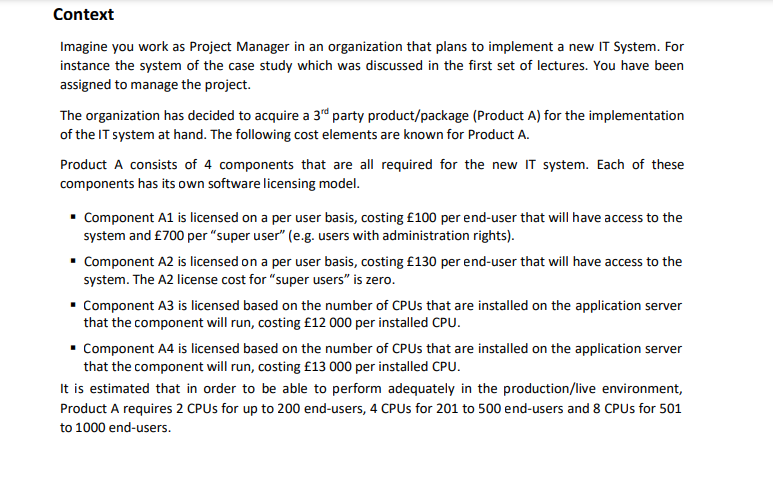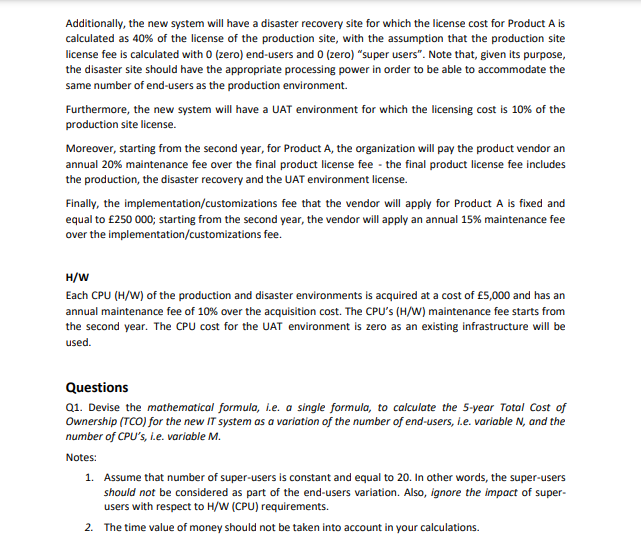Answered step by step
Verified Expert Solution
Question
1 Approved Answer
Please solve this Thank you very much Context Imagine you work as Project Manager in an organization that plans to implement a new IT System.
Please solve this



Thank you very much
Context Imagine you work as Project Manager in an organization that plans to implement a new IT System. For instance the system of the case study which was discussed in the first set of lectures. You have been assigned to manage the project. The organization has decided to acquire a 3rd party product/package (Product A) for the implementation of the IT system at hand. The following cost elements are known for Product A. Product A consists of 4 components that are all required for the new IT system. Each of these components has its own software licensing model. Component A1 is licensed on a per user basis, costing 100 per end-user that will have access to the system and 700 per "super user" (e.g. users with administration rights). . Component A2 is licensed on a per user basis, costing 130 per end-user that will have access to the system. The A2 license cost for "super users" is zero. Component A3 is licensed based on the number of CPUs that are installed on the application server that the component will run, costing 12 000 per installed CPU. . Component A4 is licensed based on the number of CPUs that are installed on the application server that the component will run, costing 13 000 per installed CPU. It is estimated that in order to be able to perform adequately in the production/live environment, Product A requires 2 CPUs for up to 200 end-users, 4 CPUs for 201 to 500 end-users and 8 CPUs for 501 to 1000 end-users. Additionally, the new system will have a disaster recovery site for which the license cost for Product A is calculated as 40% of the license of the production site, with the assumption that the production site license fee is calculated with 0 (zero) end-users and 0 (zero) "super users". Note that, given its purpose, the disaster site should have the appropriate processing power in order to be able to accommodate the same number of end-users as the production environment. Furthermore, the new system will have a UAT environment for which the licensing cost is 10% of the production site license. Moreover, starting from the second year, for Product A, the organization will pay the product vendor an annual 20% maintenance fee over the final product license fee - the final product license fee includes the production, the disaster recovery and the UAT environment license. Finally, the implementation/customizations fee that the vendor will apply for Product A is fixed and equal to 250 000; starting from the second year, the vendor will apply an annual 15% maintenance fee over the implementation/customizations fee. H/W Each CPU (H/W) of the production and disaster environments is acquired at a cost of 5,000 and has an annual maintenance fee of 10% over the acquisition cost. The CPU's (H/W) maintenance fee starts from the second year. The CPU cost for the UAT environment is zero as an existing infrastructure will be used. Questions Q1. Devise the mathematical formula, i.e. a single formula, to calculate the 5-year Total cost of Ownership (TCO) for the new IT system as a variation of the number of end-users, i.e. variable N, and the number of CPU's, i.e. variable M. Notes: 1. Assume that number of super-users is constant and equal to 20. In other words, the super-users should not be considered as part of the end-users variation. Also, ignore the impact of super- users with respect to H/W (CPU) requirements. 2. The time value of money should not be taken into account in your calculations. Q2. Based on the previous analysis and formula, use Excel or develop your own Java application, to produce a diagram of the 5-year TCO of the new IT system as a variation of the number of end-users. The diagram's vertical axis should represent the 5-year TCO, whereas the horizontal axis denotes the number of end-users ranging from 100 to 1000, in intervals of 50 end-users. Context Imagine you work as Project Manager in an organization that plans to implement a new IT System. For instance the system of the case study which was discussed in the first set of lectures. You have been assigned to manage the project. The organization has decided to acquire a 3rd party product/package (Product A) for the implementation of the IT system at hand. The following cost elements are known for Product A. Product A consists of 4 components that are all required for the new IT system. Each of these components has its own software licensing model. Component A1 is licensed on a per user basis, costing 100 per end-user that will have access to the system and 700 per "super user" (e.g. users with administration rights). . Component A2 is licensed on a per user basis, costing 130 per end-user that will have access to the system. The A2 license cost for "super users" is zero. Component A3 is licensed based on the number of CPUs that are installed on the application server that the component will run, costing 12 000 per installed CPU. . Component A4 is licensed based on the number of CPUs that are installed on the application server that the component will run, costing 13 000 per installed CPU. It is estimated that in order to be able to perform adequately in the production/live environment, Product A requires 2 CPUs for up to 200 end-users, 4 CPUs for 201 to 500 end-users and 8 CPUs for 501 to 1000 end-users. Additionally, the new system will have a disaster recovery site for which the license cost for Product A is calculated as 40% of the license of the production site, with the assumption that the production site license fee is calculated with 0 (zero) end-users and 0 (zero) "super users". Note that, given its purpose, the disaster site should have the appropriate processing power in order to be able to accommodate the same number of end-users as the production environment. Furthermore, the new system will have a UAT environment for which the licensing cost is 10% of the production site license. Moreover, starting from the second year, for Product A, the organization will pay the product vendor an annual 20% maintenance fee over the final product license fee - the final product license fee includes the production, the disaster recovery and the UAT environment license. Finally, the implementation/customizations fee that the vendor will apply for Product A is fixed and equal to 250 000; starting from the second year, the vendor will apply an annual 15% maintenance fee over the implementation/customizations fee. H/W Each CPU (H/W) of the production and disaster environments is acquired at a cost of 5,000 and has an annual maintenance fee of 10% over the acquisition cost. The CPU's (H/W) maintenance fee starts from the second year. The CPU cost for the UAT environment is zero as an existing infrastructure will be used. Questions Q1. Devise the mathematical formula, i.e. a single formula, to calculate the 5-year Total cost of Ownership (TCO) for the new IT system as a variation of the number of end-users, i.e. variable N, and the number of CPU's, i.e. variable M. Notes: 1. Assume that number of super-users is constant and equal to 20. In other words, the super-users should not be considered as part of the end-users variation. Also, ignore the impact of super- users with respect to H/W (CPU) requirements. 2. The time value of money should not be taken into account in your calculations. Q2. Based on the previous analysis and formula, use Excel or develop your own Java application, to produce a diagram of the 5-year TCO of the new IT system as a variation of the number of end-users. The diagram's vertical axis should represent the 5-year TCO, whereas the horizontal axis denotes the number of end-users ranging from 100 to 1000, in intervals of 50 end-usersStep by Step Solution
There are 3 Steps involved in it
Step: 1

Get Instant Access to Expert-Tailored Solutions
See step-by-step solutions with expert insights and AI powered tools for academic success
Step: 2

Step: 3

Ace Your Homework with AI
Get the answers you need in no time with our AI-driven, step-by-step assistance
Get Started


